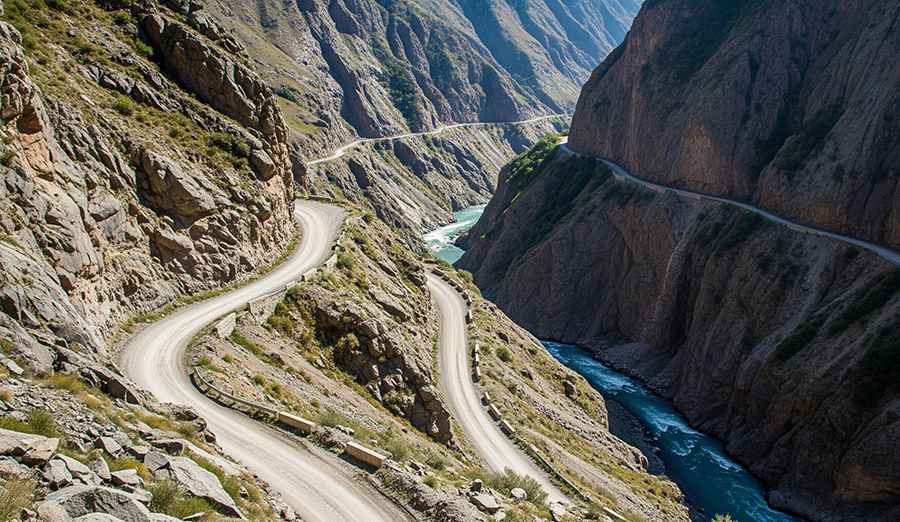Exploring the World's Most Treacherous Roads: Thrill, Beauty, and Survival
The earth is mapped. Or so we believe. GPS glows in our palms, satellites triangulate us with eerie precision, and highways promise security. But there remain veins of road where maps mean little, and certainty even less. Where a misjudged curve is more than a mistake—it’s a verdict.

There’s something disturbingly seductive about dangerous roads. Perhaps it’s the rebellion against the safe and the routine. Maybe it’s the way the scenery sharpens when you're fully aware of your own mortality. One thing is certain: extreme driving is not for the timid.
Bolivia’s Death Road: Where Fog Swallows the Guardrails
Yungas Road in Bolivia, colloquially dubbed Death Road, deserves its title. This single-lane track connects La Paz to Coroico and descends from icy Andean heights into thick Amazonian jungle—a vertical drop of more than 3,600 meters. No barriers. No mercy.
Statistics once estimated that 200 to 300 travelers per year met their end here. Trucks clinging to the edge, cyclists vanishing into green abyss. Tourists now pay for the thrill on mountain bikes, dodging landslides and mist, their adrenaline spiking as they peer over a shoulder—just gravel and then sky.
This is a scenic drive, yes. But it also reminds you that beauty has claws. And you should assess your risks in advance. Yes, even here math is involved. If you need to calculate something, it is no longer a problem with the math app on the iPhone. Anything: travel costs, air temperature during the ascent, the weight of things in your backpack...
The Frozen Arteries of the Himalayas
In India, Zoji La Pass connects Ladakh with Kashmir. Sitting at 3,528 meters above sea level, it often resembles a path carved through clouds and ice. Winter shuts it down entirely—snow, rockslides, and sheer wind chill make passage impossible. But in summer?
Ah, then the real danger begins.
Convoys of trucks crawl around hairpin turns where one false move sends a ten-wheeler into oblivion. Drivers honk constantly, a desperate Morse code in narrow sections with zero visibility. Each horn says, “I exist. Don’t hit me.” Each curve is a prayer. And yet, commerce flows. People persist. Remote travel routes become lifelines.
Trollstigen, Norway: Curves, Cascades, and Control
There are roads that kill with surprise. Others seduce with drama. And some, like Trollstigen, do both.
Eleven serpentine turns coil up Norway’s rugged landscape, bordered by waterfalls like Stigfossen roaring beside your tires. Built in 1936, this marvel of engineering demands your full attention. It’s open only in warmer months due to extreme weather and avalanche risk.
What makes Trollstigen unique isn’t just its design—it’s the illusion of calm. Tourists treat it like a theme park ride. But the combination of sudden fog, motorcyclists going too fast, and buses too big for the bends? That’s a recipe for a very real disaster.
Not every deadly highway screams. Some whisper.
Skippers Canyon Road: Adventure for the Uninsured
In New Zealand, there's a path so perilous that rental car companies explicitly forbid customers from driving it. That path? Skippers Canyon Road near Queenstown.
Built during the gold rush era, it’s carved into sheer cliffs, a winding one-lane marvel with no railings, no second chances. The rock face breathes down your neck on one side. The abyss yawns on the other.
Road safety tips for Skippers? Don’t go alone. Don’t go in the rain. And don’t assume that 4WD guarantees survival.
Still, the view—God, the view.
Offbeat Road Trips for the Brave
Not all treacherous roads are mountain passes. Some cut through deserts, some snake across political conflict zones. Take the Karakoram Highway, spanning Pakistan and China. It’s the highest paved international road in the world—dubbed the Eighth Wonder. Its construction cost thousands of lives due to landslides, altitude sickness, and the volatile terrain.
Or the James Dalton Highway in Alaska. Nearly 666 km of isolation, cold, and trucker grit. Frost heave, arctic wolves, zero gas stations for hours. Yet for the hardcore, it's paradise.
Road safety tip: satellite phones. Not luxury—necessity.
Numbers Don’t Lie, But Roads Might
A 2023 WHO report states that 1.19 million people die in road traffic accidents every year worldwide. While city collisions dominate the data, remote routes—treacherous and lawless—carry their own statistical shadows. In mountainous regions, the fatality rate can be four times higher due to poor infrastructure and lack of medical access.
Yet people still drive them. Not out of madness, but something quieter. Curiosity. Necessity. The pursuit of something untamed.
Between Romance and Ruin
What is it about extreme driving that magnetizes us? The idea that some places can only be reached with white knuckles on the wheel. That risk is the toll we pay for the extraordinary. That every cliffside corner might open into a view so staggering it rewires your soul.
Scenic drives aren’t always safe. Dangerous roads aren’t always avoidable. But they all carry a story, and for the willing—an invitation.
Final Thoughts: Survive, Don’t Just Drive
A last note, should you find yourself itching for your own offbeat road trip:
- Check the weather daily. Roads like Argentina’s Route 40 or Peru’s Andes passages can turn fatal with a single storm.
- Invest in navigation that works offline. Remote travel routes often mean no signal.
- Learn local customs. In Kyrgyzstan’s mountains, drivers flash lights for different reasons than in France or Thailand.
- Don’t chase the thrill blindly. Respect the road, or it may not return the favor.
Adventurous travel doesn’t mean reckless travel. Even the wildest journey starts with preparation.
So go—explore the brutal and the beautiful. Just make it back.